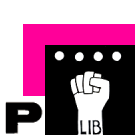User:Jules/departure: Difference between revisions
(Created page with "<div> <p><i>“A computer will make copies of all the data it operates with, and so <b>the internet is basically a huge assemblage of copying machines.</b> In the digital worl...") |
No edit summary |
||
| Line 1: | Line 1: | ||
<div> | |||
< | <div style="width:60%;"> | ||
Michael Seemann – Digital tailspin | |||
</ | |||
''<span style="color:GoldenRod;">“A computer will make copies of all the data it operates with, and so <b>the internet is basically a huge assemblage of copying machines.</b> In the digital world, practically everything we come into contact with is a copy. This huge copying apparatus is growing more powerful every year, and will keep on replicating more and more data everywhere.“</span> <br> | |||
< | <sup>Michael Seemann – Digital tailspin</sup> | ||
<i>“At present, there are at least twenty torrents of Chris Marker’s film essays available online. If you want a retrospective, you can have it. But the economy of poor images is about more than just downloads: <b>you can keep the files, watch them again, even reedit or improve them if you think it necessary. And the results circulate.</b> Blurred AVI files of half-forgotten masterpieces are exchanged on semi-secret P2P platforms. Clandestine cell-phone videos smuggled out of museums are broadcast onYouTube. DVDs of artists’ viewing copies are bartered.Many works of avant-garde, essayistic, and non-commercial cinema have been resurrected as poor images. Whether they like it or not.”</i><br> | |||
Hito Steyerl – In defense of the poor image</ | |||
''<span style="color:GoldenRod;"><i>“At present, there are at least twenty torrents of Chris Marker’s film essays available online. If you want a retrospective, you can have it. But the economy of poor images is about more than just downloads: <b>you can keep the files, watch them again, even reedit or improve them if you think it necessary. And the results circulate.</b> Blurred AVI files of half-forgotten masterpieces are exchanged on semi-secret P2P platforms. Clandestine cell-phone videos smuggled out of museums are broadcast onYouTube. DVDs of artists’ viewing copies are bartered.Many works of avant-garde, essayistic, and non-commercial cinema have been resurrected as poor images. Whether they like it or not.”</i></span><br> | |||
<sup>Hito Steyerl – In defense of the poor image</sup> | |||
</div> | </div> | ||
Latest revision as of 23:10, 4 November 2015
“A computer will make copies of all the data it operates with, and so the internet is basically a huge assemblage of copying machines. In the digital world, practically everything we come into contact with is a copy. This huge copying apparatus is growing more powerful every year, and will keep on replicating more and more data everywhere.“
Michael Seemann – Digital tailspin
“At present, there are at least twenty torrents of Chris Marker’s film essays available online. If you want a retrospective, you can have it. But the economy of poor images is about more than just downloads: you can keep the files, watch them again, even reedit or improve them if you think it necessary. And the results circulate. Blurred AVI files of half-forgotten masterpieces are exchanged on semi-secret P2P platforms. Clandestine cell-phone videos smuggled out of museums are broadcast onYouTube. DVDs of artists’ viewing copies are bartered.Many works of avant-garde, essayistic, and non-commercial cinema have been resurrected as poor images. Whether they like it or not.”
Hito Steyerl – In defense of the poor image
